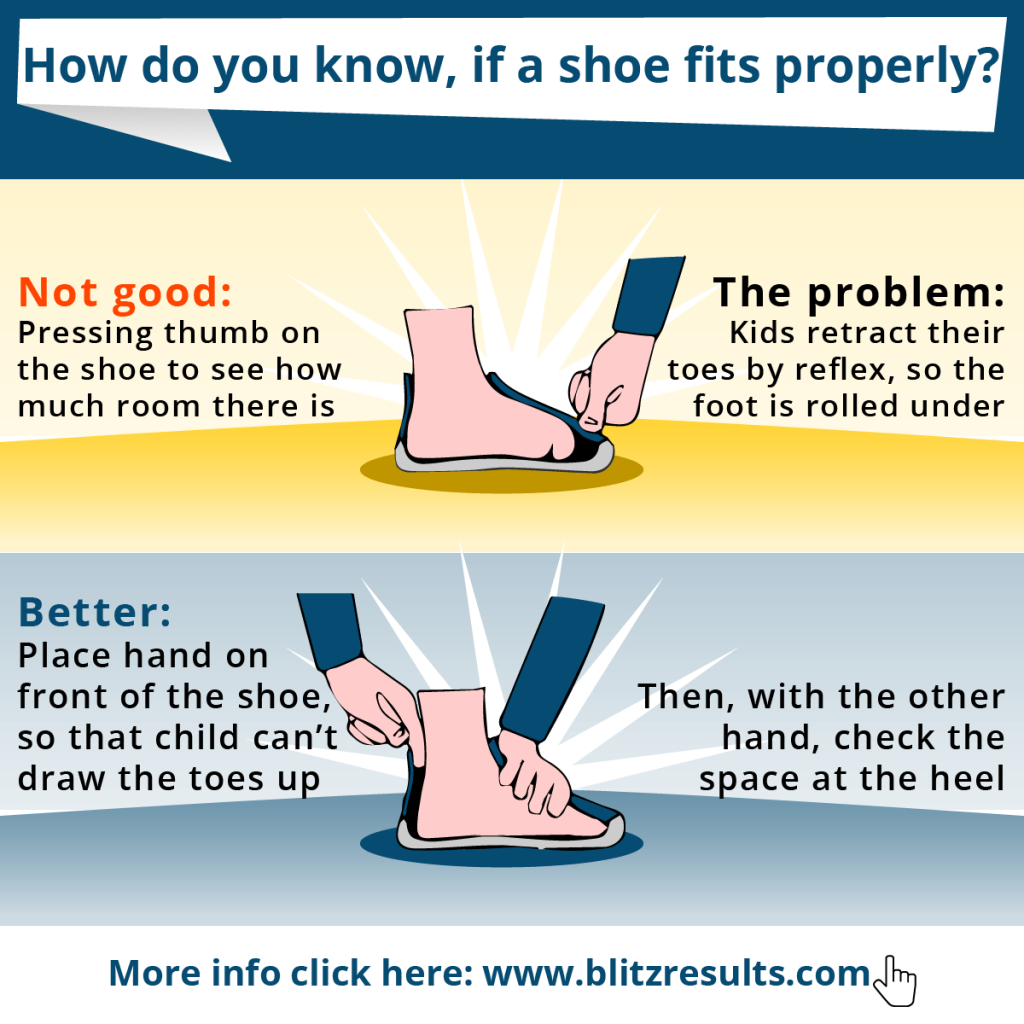Shoes that are too small put children at risk of foot deformities and other serious health issues. The bad news for parents; almost two-thirds of all children are wearing shoes that are too small!
BlitzResults conducted a survey recently and found that 67% of all kids are wearing shoes that are too small. Improperly fitting shoes can cause hallux valgus. This is a foot deformity that happens when the big toe starts to angle inward, which causes a swollen lump just below the big toe. A relating study conducted by the National Health Institute found that almost 30% of children had irreversible foot deformities, like hallux valgus.
Main findings of the survey
- 67% of all kids are wearing shoes that are too small. Of these, 48% are one size too small and 19% are even two.
- Only 33% are wearing the correct size, and only 10 % of those have room to grow.
- Of the parents surveyed, 52% said they’d never measured their kid’s foot length but instead relied solely on sensorial and visual tests.

About the study
2789 parents were asked about their kids’ foot length and shoe size. Feet were measured with measuring devices and scanners, then these results were compared with the parents’ hit or miss values.

Download study (pdf) / raw data (xlsx, 120 mb)
How to buy the right sized shoes?
To help parents make sure they are buying shoes that fit their kids properly, keep the following advice in mind:
- Go by the longer foot: The right and left foot are rarely the same length. A difference of up to half an inch is normal, that’s almost one whole shoe size. Therefore, parents should always go by the longer foot when buying shoes.
- Don’t rely on the shoe size: Shoe manufacturers label shoes with standard sizes, the ones we all know. But, there is no mandatory industry standard for shoe sizing, so each brand will vary. Be sure to try on every shoe carefully.
- Give ‘em room: Most parents are aware that feet need some room, but usually underestimate the actual room needed. At least ½ inch of additional room is optimal, it’s the only way kids can roll their foot properly when walking.
- Do a regular check: “Because the sense of touch isn’t fully developed in children yet, they have a tendency to squeeze their feet into shoes that are much too small, they don’t even notice it. Therefore, parents must measure their children’s feet every 2 months.” A measuring guide, useful conversion tools and a lot of information on how to choose shoes with the perfect fit can be found at https://www.blitzresults.com/en/childrens-shoe-sizes/


These tricks are inadequate
Unfortunately, many parents still use these “tricks” to judge whether shoes fit:
- Trick: Hold shoe to foot. The shoe sole is held up to the child’s foot to estimate the size, but the length on the inside of the shoe can’t be estimated from the outside and is often much shorter than you’d expect (lining, seams, footbed). Better: Use an appropriate measuring device.
- Trick: The thumb test. The thumb presses on the toe of the shoe to see how much room there is to grow. The problem; children often draw their toes up by reflex, so the foot is rolled under. It may seem like there’s enough room, although, in reality, the shoes are too small. Using the heel test is just as bad for judging free space in the heel. Many kids push their feet forward until their toes are crammed in. Better: Carefully feel your child´s foot inside the shoe. Place one hand on the front of the shoe, so the child can’t draw their toes up. Then, with the other hand, check the position of the toes. This way you can feel whether there is enough room to grow.
- Trick: Size comparison using a stencil. The shape and size of the foot is traced and compared with the shoe sole, but this comparison is usually imprecise. Better: If there is a removable insole, take it out and place the foot on the insole, there should be 1/3 inch of space behind the heel and half an inch in front of the toes.
- Trick: Asking them how it feels. Parents ask kids; “Does the shoe fit?” Unfortunately, the answer will likely be wrong. Often, the nerves in kid’s feet are not fully developed yet and their awareness of pain is clearly lower than an adult’s, so, kids don’t realize if the shoe fits. Better: First and foremost, measure their feet.

References
Insights from our Lab
This is how we work: watch the video and see how we measure and research in our lab.
